
|
The MCON-35 Macro Attachment for the Olympus E-10 and E-20 |

| My other articles related to the Olympus E-10 and E-20 cameras |
| General information | |
|
MCON-35 is a high-quality close-up attachment lens for the Olympus E-10 camera. It will also work just fine with other cameras (or lenses) fitted with a 62-mm front thread.
The focal length of the MCON-35 is 35 cm (according to Olympus), which translates into +3 diopters. The attachment is achromatic: it focuses all visible light wavelengths (spectral colors) of a point source at the same distance. (Well, this is not quite true, but the differences are much less than in case of non-achromatic lenses.) |
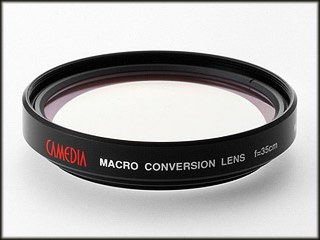
|
|
An achromatic lens has to consist of at least two elements (pieces of glass). Usually the one at the front is positive, or convex (thicker at the center), and the rear one — negative, or concave (thinner at the center). The whole trick is based on using two different kinds of glass: the concave element has to neutralize the dispersion (color dependency) of the convex one, while not neutralizing its refraction (light-bending capability). It was invented in 1821, when there was no World Wide Web (this remark is addressed to younger readers).
Most close-up attachments are single-element, and therefore not achromatic. This results in image unsharpness, and — for shorter focal lengths — chromatic aberration. At focal lengths down to 25 cm or so (up to +4 diopters) the chromatic aberration is often considered acceptable (whatever that means); this is why manufacturers just don't bother. Besides, charging $60 for a set of three single-element lenses leaves a nice profit margin. With the two-element, achromatic construction of MCON-35 Olympus managed to achieve very high optical quality, at least as far as front-end close-up attachments go. I've been using this one for the last two months and I am impressed with the results. Oh yes, the thing is also multicoated. The full Monty. | |
| Minimum subject distance and field of view | |
|
In spite of the fact that the effective lens viewing angle slightly increases when a close-up attachment is used (the combined focal length is smaller than that of the camera lens alone), higher magnifications become possible because the minimum focusing distance decreases even more.
For MCON-35, the gain is by a factor of about 1.55. Here are the numbers as given by the manufacturer. | |
|
Equivalent focal length | Without MCON-35 | With MCON-35 | ||
| Min. distance | Field of view | Min. distance | Field of view | |
| 35 mm | 20 cm (8") | 234 x 172 mm | 12 cm (4.8") | 147 x 110 mm |
| 140 mm | 76 x 57 mm | 49 x 37 mm | ||
| Using filters | |
| Increasing the distance between the camera lens and the attachment is not recommended (loss of image quality and of close-up gain), therefore there should be no filter between them. If you would like to use a filter, it has to be attached to the front of MCON-35. Its front thread is 72 mm in diameter — larger than the rear one, to avoid vignetting. Thoughtful. | |
| Image samples | |
|
Here is an example showing the effect of using the MCON-35 macro attachment on the Olympus E-10. (The camera shown in the pictures is a vintage Exakta II from 1948, one of the first 35-mm SLRs ever made, still in working order.)
The pictures were taken in the aperture priority mode at F/11, following the ESP matrix metering. The zoom lens was at its long end, and a tripod was used. Open shade, sky blocked with a piece of cardboard. All pictures were saved as full-resolution, 1:8 JPEGs. The images at the left were reduced and slightly re-sharpened. The cropped samples at the right (320x240 pixels) were resaved at a very low JPEG compression with no postprocessing at all. When scrutinizing the samples, remember that in an 8x10-inch (20x25 cm) print each of them will be just 1.14" (29 mm) tall. | |
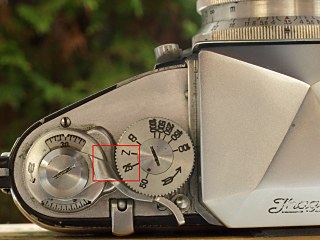
|
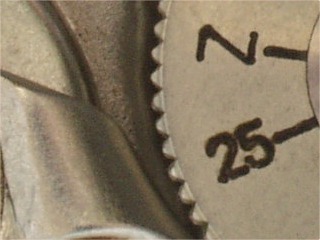
| |
| Without MCON-35, distance of 20 cm (8") | 1:1 sample from the image at the left | |
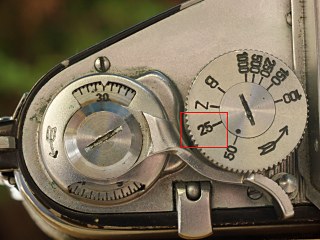
|
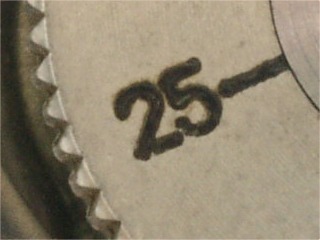
| |
| With MCON-35, distance of 12.5 cm (5") | 1:1 sample from the image at the left | |
|
Instead of using a close-up attachment we might think of cropping the original image, and resizing it as needed ("digital zoom").
Just to see how much I'm getting for my $90, I have resized the picture taken without MCON-35 (top left) so that it shows the subject in the same scale. (The resized sample was submitted to some sharpening and equalization.) The scale factor was only 1.55, therefore the loss of quality is not outrageous. It is, however, clearly visible; MCON-35 gives, as expected, much better results. |

1:1 sample from the resized image | |

| My other articles related to the Olympus E-10 and E-20 cameras |
| Home: wrotniak.net | Search this site | Change font size |
| Posted 2001/04/27; last updated 2002/06/15 | Copyright © 2001-2002 by J. Andrzej Wrotniak |